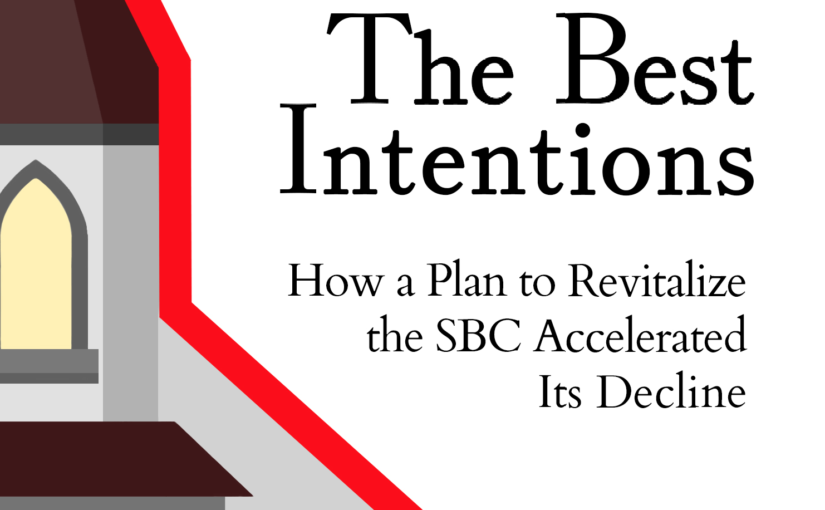Allow me to share a little of my background for those who may be reading this blog for the first time:
I’m a lifelong Southern Baptist. I grew up attending the Southern Baptist church that my family has now attended for four generations. I responded to the gospel and was baptized in that church. I was also licensed and ordained into ministry in that church.
I have benefited greatly from what we Southern Baptist do cooperatively. I have been blessed to attend two of our seminaries at a significant discount due to the funding these schools receive from the Cooperative Program. I also spent three of my eleven years in the Philippines as a missionary of the International Mission Board.
I have now been the pastor of a Southern Baptist church for over 6 years here in El Paso, Texas.
I haven’t been deeply involved in the politics of my denomination, but do I care about what happens within it.
I first learned about The Best Intentions book on Facebook. I have been very eager to read it, so I asked Dr. Kelley for a review copy. His publisher has granted my request, so here goes:
Summary
Kelley begins the book by answering two questions: “Who are Southern Baptist,” and “What Do Southern Baptists Do?”
I’ll give an abbreviated version of his answer: Southern Baptists are a network of autonomous churches that cooperate for the sake of the gospel. Part of this cooperation is accomplished through the Cooperative Program (CP), a system implemented in 1926. This system allows all churches to support ministry at the local, state, national and international level by giving a percentage of their offerings to the CP. This ingenious system means SBC churches of every size can contribute to ministry efforts that none of them would be able to do individually.
Kelley also gives a historical sketch of the Conservative Resurgence, a movement within the Southern Baptist Convention (SBC) that began in 1979. The Conservative Resurgence shifted the SBC entities and seminaries in a more theologically conservative direction after years of liberal drift. One important aspect of the Conservative Resurgence, Kelley notes, is the grassroots nature of the movement. In other words, the movement was driven by the expressed beliefs of typical SBC churches/members (a high view of Scripture, etc.).
The Great Commission Resurgence (GCR) is a term that appeared years later (2008). The term was intentionally fashioned after the Conservative Resurgence. But Kelley notes a very important distinction between the two movements: the GCR was not grassroots in nature. There was not a widespread call among rank-and-file Southern Baptist for reforms in the way we do ministry and missions. The initiatives were top-down, or as Kelley puts it, “Convention-driven initiatives rather than church-based initiatives.”
The initiatives of the Great Commission Resurgence were approved by the Southern Baptist Convention in 2010. Some of the initiatives that were passed (such as the mission statement) were completely inconsequential. But the GRC led to two radical changes in the way the North American Mission Board functioned.
The first change was a drastic reduction in resources devoted to evangelism. The NAMB has historically helped Southern Baptist churches and agencies develop strategies to evangelize the lost. But the NAMB’s emphasis has overwhelmingly shifted to church-planting. Unfortunately, it does not seem this has resulted in more churches being planted than with previous strategies: “In the ten years after GCR, NAMB spent $439,943,569 more money on church planting but employed significantly fewer church planters and started significantly fewer new churches.”
The second major change came the way the NAMB related to state conventions. Previously, the NAMB had “Cooperative Agreements” with each state convention. The NAMB and the state leadership would negotiate the amount of funding the state would receive as well as who was responsible for what. This required compromise on the part of both entities, but it also built mutual trust and created buy-in for the Cooperative Program. States could see first-hand how their cooperative program promotion and giving benefited the ministries within their conventions.
Even southern states would get some NAMB funding for certain ministries. I am, for example, originally from Alabama. The NAMB used to fund campus ministry in two of our historically black colleges.
The GCR changed this. The NAMB was given unprecedented control of cooperative program dollars, in essence bypassing the states conventions: “Having eliminated the Cooperative Agreements, NAMB chose to do much more than simply not increase its support for non-South conventions. It actually pulled funding for evangelism and church planting out of several of these convention budgets, creating a fiscal crisis for the Great Commission work in the most unreached parts of North America.”
NAMB leadership has gone so far as to require some state convention leaders to sign Non-Disclosure agreements. These contracts forbid state leaders from discussing their financial arrangement with the NAMB or criticising the NAMB.
As you can imagine, this has been a recipe for conflict between the NAMB and state conventions—conflicts which have not fully been resolved. These conflicts have likely harmed the cooperative spirit that historically fueled cooperative giving among our churches.
Kelley has included a lot more details than what I have written in this summary (a lot more eye-opening details). What I’ve tried to do here is present some of the highlights that stood out to me as I read.
Thoughts/Review
Change is often painful but necessary part of ministry. Here is the crucial question: were the changes brought about by the Great Commission Resurgence good for our convention? Based on the data presented in the book, the answer is “no.” The SBC has seen dramatic decline in virtually every meaningful metric over the past decade (the data is in the book).
Many states, for example, have responded to the GCR challenge of passing along a higher percentage of their offerings along to the national-level entities/ministries. The GCR was “successful” in that sense. But the higher percentage has come from an overall lower amount, meaning the net effect is less money going to missions.
I think Dr. Kelley has brought up some very serious concerns regarding the consequences of the Great Commission Resurgence and the current direction of the Southern Baptist Convention. I encourage my fellow Southern Baptists to read this book and examine the data for themselves.
The book is available here: The Best Intentions (Northeastern Baptist Press).

